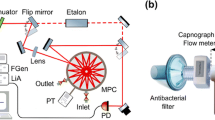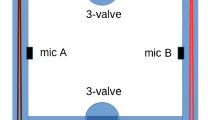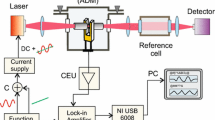Abstract
A continuous wave, single frequency and continuously tunable optical parametric oscillator is used in combination with photoacoustic spectroscopy to detect trace emissions of CO2 from insects under atmospheric conditions. The optical parametric oscillator (OPO) contains a periodically poled lithium niobate crystal and is tunable over the 3.9 to 4.8 μm infrared wavelength region. With the strong rotational-vibrational absorption band of CO2 at 4.23 μm, it is possible to detect CO2 down to 7 parts per billion volume using 20 mW of the OPO beam. This detection sensitivity was achieved by adding 4% of SF6 gas to the atmospheric gas mixture to overcome the slow vibrational relaxation of the excited CO2 levels. The usefulness of this system is demonstrated by real-time measuring of the fluctuations of the CO2 concentration in the breath of a single ant (Lasius niger) and individual fruit flies (Drosophila melanogaster).
Similar content being viewed by others
References
Harren FJM, Cotti G, Oomens J, te Lintel Hekkert S (2000) Photoacoustic Spectroscopy in Trace Gas Monitoring, In Encyclopedia of Analytical Chemistry, Meyers RA (ed). Wiley, Chichester, pp 2203–2226
Berden G, Peters R, Meijer G (2000) Int. Rev. Phys. Chem. 19:565
Tittel FK, Richter D, Fried A (2003) Appl. Phys. 89:445
Bijnen FGC, Reuss J, Harren FJM (1996) Rev. Sci. Instrum. 67:2914
Bijnen FGC, Zuckermann H, Harren FJM, Reuss J (1998) Appl. Opt. 37:3345
Paldus BA, Spence TG, Zare RN, Oomens J, Harren FJM, Parker DH, Gmachl C, Capasso F, Sivco DL, Baillargeon JN, Hutchinson AL, Cho AY (1999) Opt. Lett. 24:178
Nelson DD, Shorter JH, McManus JB, Zahniser MS (2002) Appl. Phys. B 75:343
Kosterev AA, Tittel FK (2002) IEEE J. Quantum Electron. QE-38:582
Van Herpen M, Li S, Bisson SE, Harren FJM (2002) Appl. Phys. Lett. 81:1157
van Herpen M, Bisson SE, Harren FJM (2003) Opt. Lett. 28:2497
Rothman LS, Barbe A, Benner DC, Brown LR, Camy-Peyret C, Carleer MR, Chance K, Clerbaux C, Dana V, Devi VM, Fayt A, Flaud JM, Gamache RR, Goldman A, Jacquemart D, Jucks KW, Lafferty WJ, Mandin JY, Massie ST, Nemtchinov V, Newnham DA, Perrin A, Rinsland CP, Schroeder J, Smith KM, Smith MAH, Tang K, Toth RA, van der Auwera J, Varanasi P, Yoshino K (2003) J. Quant. Spectrosc. Radiat. Transfer 82:5
Bosenberg WR, Drobshoff A, Alexander JI (1996) Opt. Lett. 21:1336
Myers LE, Bosenberg WR (1997) IEEE J. Quantum Electron. QE-33:1663
Powers PE, Kulp TJ, Bisson SE (1998) Opt. Lett. 23:159
Klein ME, Laue CK, Lee D-H, Boller K-J, Wallenstein R (2000) Opt. Lett. 25:490
van Herpen WMMJ, te Lintel Hekkert S, Bisson SE, Harren FJM (2002) Opt. Lett. 27:640
van Herpen WMMJ, Li S, Bisson SE, te Lintel Hekkert S, Harren FJM (2002) Appl. Phys. B 75:329
Lowenthal DD (1998) IEEE J. Quantum Electron. QE-34:1356
Loza-Alvarez P, Brown CTA, Reid DT, Sibbett W, Missey M (1999) Opt. Lett. 24:1523
Watson MA, O’Connor MV, Lloyd PS, Shepherd DP, Hanna DC, Gawith CBE, Ming L, Smith PGR, Balachninaite O (2002) Opt. Lett. 27:2106
Rooth RA, Verhage AJL, Wouters LW (1990) Appl. Opt. 29:3643
Buchwald MI, Bauer SH (1972) J. Phys. Chem. 76:3108
Lighton JRB, Garrigan D (1995) J. Exp. Biol. 198:1613
Kestler A (1985) Respiration and respiratory water loss, In Environmental Physiology and Biochemistry of Insects, Hoffmann KH (ed). Springer, Berlin, pp 137–183
Lighton JRB (1994) Physiol. Zool. 67:142
Williams AE, Rose MR, Bradley TJ (1997) J. Exp. Biol. 200:615
Popp A, Muller F, Kuhnemann F, Schiller S, von Basum G, Dahnke H, Hering P, Murtz MA (2002) Appl. Phys. B 75:751
van Herpen WMMJ, Bisson SE, Ngai AKY, Harren FJM (2004) Appl. Phys. B 78:281
Kulp TJ, Bisson SE, Bambha RP, Reichardt TA, Goers UB, Aniolek KW, Kliner DAV, Richman BA, Armstrong KM, Sommers R, Schmitt R, Powers PE, Levi O, Pinguet T, Fejer M, Koplow JP, Goldberg L, Mcrae TG (2002) Appl. Phys. B 75:317
Author information
Authors and Affiliations
Corresponding author
Additional information
PACS
42.65.Yj; 82.80.Kq; 42.62.Fi
Rights and permissions
About this article
Cite this article
van Herpen, M., Ngai, A., Bisson, S. et al. Optical parametric oscillator-based photoacoustic detection of CO2 at 4.23 μm allows real-time monitoring of the respiration of small insects. Appl. Phys. B 82, 665–669 (2006). https://doi.org/10.1007/s00340-005-2119-4
Received:
Revised:
Published:
Issue Date:
DOI: https://doi.org/10.1007/s00340-005-2119-4




